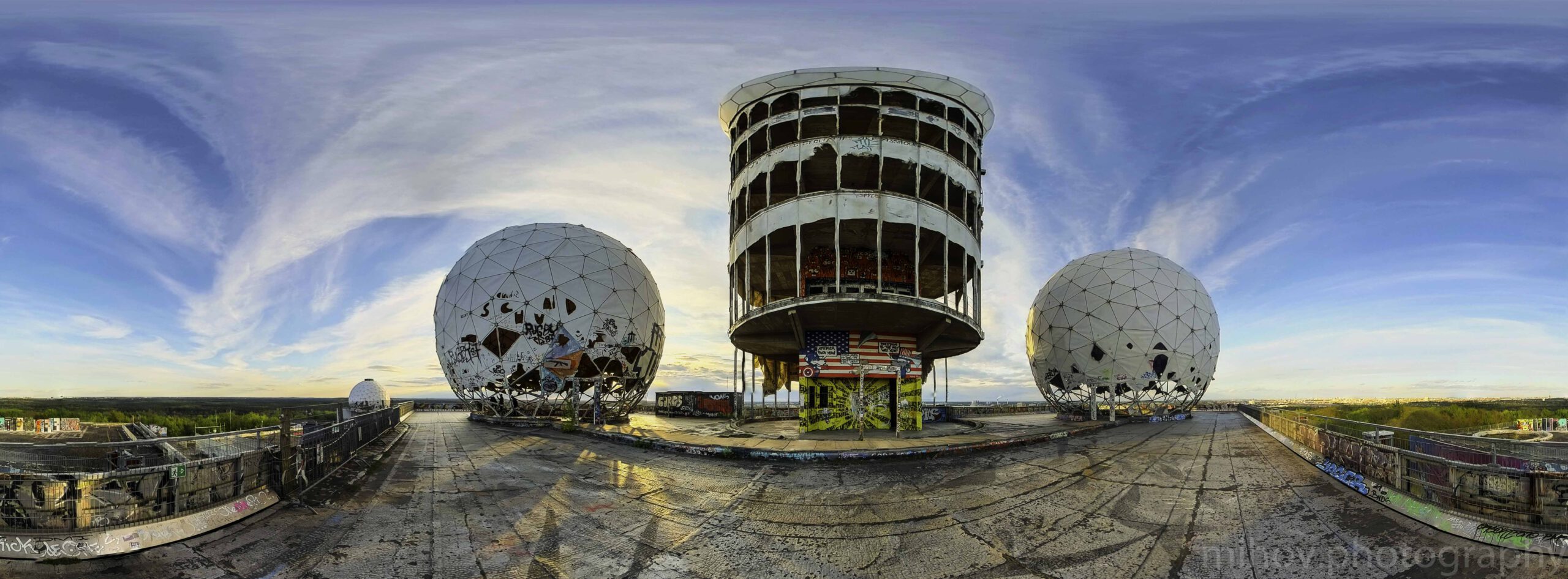
With its 120 meters, Teufelsberg rises above Grunewald and is today Berlin’s second-highest hill. The accumulation of rubble after World War II shapes its structure and buries the unfinished construction of the Technical Faculty for Military Technology, which was supposed to be built by the National Socialists in the 1940s as part of Hitler’s grandiose project for Germany and the Thousand-Year Reich. In the 1960s, the USA built a listening station on the summit of the rubble hill to monitor the East during the Cold War. After the Cold War ended, in the 1990s, air traffic safety temporarily used the former listening station as a radar station.
360° view:
After unsuccessful reuse concepts, the still visible ruins of the listening station on Teufelsberg remain one of Berlin’s most famous abandoned places. Currently, the abandoned buildings house an art installation for graffiti talents on various themes. From what I saw, there are exceptionally well-positioned messages, some of which you can see in this virtual tour. Now, a bit more about the building’s activity during the Cold War:
Construction of the Wall and the establishment of the NSA listening station on Teufelsberg
With growing dissatisfaction with the economic and political development in the GDR, more and more people fled to the West in the early 1960s. In response, the GDR government halted this movement with the construction of the Wall in 1961. However, this significantly restricted the freedom of movement for spies, and in the following decades, Western intelligence agencies like the NSA focused more on technical espionage – the so-called eavesdropping.
In divided Berlin, Teufelsberg, as the highest elevation at the time, offered the optimal location for the intelligence agencies of the USA and Great Britain to eavesdrop on the East. In the 1950s, mobile equipment was initially used. From 1963, permanent buildings began to be constructed – Field Station Berlin was established. During the Cold War, it was one of the most important listening stations in the world. With its distinctive radar domes, it was part of the global ECHELON surveillance network until the early 1990s.
Americans and Britons eavesdrop on the East together
After the Allies’ victory over Germany and the end of World War II, the USA and the United Kingdom (UK) agreed on particularly close cooperation between their intelligence agencies with the “UK-USA Security Agreements” to enhance military intelligence on the Eastern Bloc. Officially, the American and British military operated the listening station on Teufelsberg. However, the NSA primarily set the espionage targets.
The main purpose was to monitor the radio communications of the GDR armed forces and the military of other Warsaw Pact states. Up to 1,500 intelligence officers eavesdropped on conversations there until the end of the Cold War. Equipped with the latest technology, they documented radio communications day and night within a range of up to 250 kilometers. In conjunction with other facilities, distances of up to 500 kilometers were possible. It turned out that the Ferris wheel at the annual folk festival on Hüttenweg in West Berlin significantly improved the reception of signals by amplifying their transmission. By order, the Ferris wheel remained in place for some time after the festivals.
Travis Trophy of the NSA for successful espionage
Whether it was this unintended assistance, modern technology, or round-the-clock operation – Field Station Berlin appears to have been very successful in intelligence gathering. It was awarded the prestigious Travis Trophy four times, in 1973, 1983, 1985, and 1989. The Travis Trophy is the annual award of the NSA for the world’s best strategic SIGINT collection station (Signals Intelligence: Radio and Electronic Intelligence).
Gallery:
е-майл: info@teufelsberg-berlin.de
Radarstation Teufelsberg
Teufelsseechaussee 10
D 14193 Berlin (Berlin-Westend)
Daily from 11.00 to 20:30,
Last admission 19.30